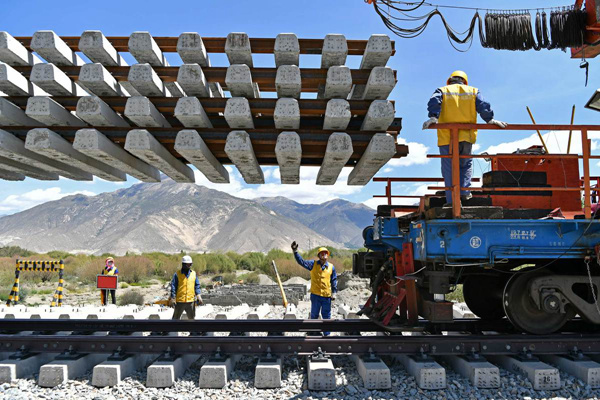(China Daily)08:37, July 09, 2019![]()

Workers deliver new railroad ties for Sichuan-Tibet railway in Dranang, the Tibet autonomous region, in June. [Photo/Xinhua]
The building of the Sichuan-Tibet railway is picking up steam, with construction work on nine new stations on the Lhasa-Nyingchi section in the Tibet autonomous region to begin soon, according to railway authorities.
The Office of the Leading Group of Railway Construction and Operation in Lhasa, Tibets regional capital, said last week that the nine stations will be built by China Railway Construction Group and China Railway Construction Engineering Group, which won the bidding for the project, but the exact date that work will commence has yet to be determined.
An earlier report by Lhasa Radio and TV Station on one of its WeChat accounts said work on the stations was expected to begin this month and will be completed by the end of next year.
The laying of track on the 435.48-kilometer Lhasa-Nyingchi section, one of the easier parts of the Sichuan-Tibet railway, began in October, following four years of work to prepare for it. Trains traveling at 160 kilometers per hour are expected to begin running on that section by 2021.
The Sichuan-Tibet railway was first proposed more than a century ago, with the idea revived after the foundation of the Peoples Republic of China in 1949, but various hurdles prevented it from progressing. Trains finally began running on the first section of the line to open, from Chengdu to Yaan in Sichuan province, in December.
The third section of the line, between Yaan and Nyingchi, will be one of the worlds most challenging railway projects because it winds through the Sichuan Basin, Yunnan-Guizhou Plateau and Qinghai-Tibet Plateau, climbing from 600 meters above sea level to nearly 4,500 meters, according to Zhao Jian, a professor of rail transportation at Beijing Jiaotong University.
It will go through complicated geological conditions fraught with avalanches, landslides, earthquakes, heat, karst caves and underground streams, he said.
At its annual work conference in January, national railway operator China State Railway Group, which was then called China Railway Corp, said it would complete the feasibility study for the Yaan-Nyingchi section by June and finish preparations for construction by the end of September. The group is also in charge of national railway planning and construction.
Things seem to have been progressing rapidly in the past month. Peoples Railway Daily, which is sponsored by the group, reported that the company reviewed the feasibility study for the Yaan-Nyingchi section on June 4 and reached a consensus that would be passed on.
On June 17, Peng Qinghua, Party secretary of Sichuan, said at a news conference that construction of the Yaan-Nyingchi section, spanning about 1,000 km, would begin soon.
Bridges and tunnels will cover over 90 percent of the line, which means there will be nearly 800 km of tunnels and more than 100 km of bridges, he said.
The next day, when China State Railway Group announced its name change, finalizing its restructuring, it was disclosed that a new office had been established to lead the Sichuan-Tibet railway project. A new company, Sichuan-Tibet Railway, was also added to the existing 18 railway bureaus and companies controlled by the group.
On June 26, various government departments in Sichuan discussed the route selected for the Yaan-Nyingchi section in the province and reached a consensus on the proposed route, according to the website of Sichuans Department of Natural Resources.
Zhao, the professor, said, Once in operation, the rail line will help Sichuan province build itself into an inland transportation hub within China as well as a bridge that connects the country with South Asian countries including Nepal and India, which will greatly boost the economy in southwestern China with convenient transportation.
The Sichuan-Tibet railway will be the second rail line connecting Tibet with the rest of the country. The 1,956-km Qinghai-Tibet Railway opened in 2006.
